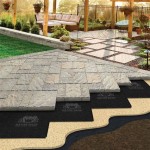How to Build Patio Steps Out of Pavers: Ideas and Instructions
Adding steps to a patio or retaining wall not only enhances aesthetics but also improves accessibility and functionality. Pavers are a durable and versatile material that can be used to create elegant and sturdy steps. This article provides a comprehensive guide on how to build patio steps out of pavers, including essential considerations and step-by-step instructions.
1. Planning and Design
Before embarking on the construction process, meticulous planning is paramount. This involves defining the following aspects:
a) Step Dimensions
Determine the desired height and width of the steps. Consider the overall dimensions of the patio or retaining wall, the intended use of the steps (e.g., pedestrian or vehicular traffic), and local building codes.
b) Material Selection
Choose pavers that complement the existing patio or landscape design. Consider factors such as color, texture, and durability. Seek professional advice to ensure the pavers are suitable for the intended load and weather conditions.
c) Layout and Alignment
Plan the layout of the steps, ensuring they are properly aligned with the patio or retaining wall. Mark the location of each step using stakes and string.
2. Site Preparation
Proper site preparation ensures a solid foundation for the steps. Follow these steps:
a) Excavation
Excavate the area where the steps will be built to the desired depth. The depth should accommodate the pavers, bedding material, and drainage layer.
b) Compaction
Compact the excavated soil thoroughly to prevent future settling. Use a plate compactor or manual tamper to achieve adequate compaction.
c) Drainage
Install a drainage system to prevent water accumulation beneath the steps. This can be achieved using gravel, perforated pipe, or other suitable drainage methods.
3. Construction of the Steps
Once the site is prepared, construct the steps following these guidelines:
a) Foundation
Create a solid foundation for the steps using concrete or compacted gravel. The foundation should be level and extend beyond the width of the steps to provide stability.
b) Bedding Material
Apply a layer of bedding material, such as sand, gravel, or mortar, on top of the foundation. The bedding material should be level and compacted to ensure proper support for the pavers.
c) Laying Pavers
Place the pavers on the bedding material, ensuring they are tightly fitted and aligned. Use a paver tamper to compact the pavers and create a level surface.
d) Joints
Leave expansion joints between the pavers to accommodate movement due to temperature fluctuations. Fill the joints with sand or polymeric sand to prevent weed growth and stabilize the pavers.
4. Finishing Touches
Once the steps are constructed, add finishing touches to enhance their aesthetics and functionality:
a) Edge Restraints
Install edge restraints around the steps to prevent the pavers from shifting or spreading. Edge restraints can be made of concrete, metal, or wood.
b) Handrail
Consider adding a handrail for safety, especially if the steps are high. The handrail should be sturdy and installed according to local building codes.
c) Landscaping
Enhance the surrounding area by adding landscaping elements such as plants, shrubs, or groundcover. These elements can add visual appeal and soften the edges of the steps.

C And D Landscape Company Patio Steps Stairs Design

Building A Paver Patio Step Elisa S Ramblings

Paver Steps Landings Chicagoland Hardscapes By Design Pavers

The Best Paver Steps Design Ideas Js Brick Pavers

How To Use Stone Pavers Build Steps Rels

48 Best Paver Steps Ideas Backyard Patio

Raised Pavers Patio Reconstructed Steps Stairs Concrete

Backyard Patio Steps 10 Ideas To Build For Your Home Arinsolangeathome

How To Build A Stone Step For Your Raised Patio Western Interlock

Paver Step Replacing Concrete Steps Avoiding Shifting
Related Posts








